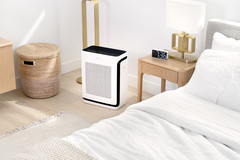
Do air purifiers benefit families with pets?
-
1 min read
Indoor air quality plays a vital role in our lives. Just by walking into a room, we can almost immediately tell if the quality of the air is subpar. You may smell something foul or even experience a reaction of some kind, like sneezing or a headache. Families with pets may struggle more than others due to airborne pet dander and fur.
At the end of the day, you want your home to be fresh and inviting. Purifying your air is a great way to ensure comfort for you, your family, and your beloved pets.
Can pets contribute to low air quality?
Can pets contribute to low air quality?
As much as we love them anyway; yes, they can. Every time a furry pet shakes their mane or jumps, their dander, fur, and even that cluster of pollen clinging to their tail after playtime outside, can become airborne and lower your air quality.
Litter boxes and potty accidents also contribute to subpar air quality, releasing ammonia into your home’s atmosphere while simultaneously making noses wrinkle in distaste.
Keeping your home fresh with pets may feel like a daunting task, but an air purifier can help.
What kind of air purifier is best for homes with pets?
The most important part of any air purifier is, unsurprisingly, the filtration system. High-quality air purifiers can trap microscopic particles down to 0.3 microns in size, including pet dander, dust, smoke particles, and pollen. This level of filtration is essential for any household with pets that may produce or track in these tiny contaminants.
If you’re also bothered by pet-related odors, an air purifier with activated carbon filtration is essential. Activated carbon basically acts like crumpled sticky tape. As gases pass through, they “stick” to the carbon and are prevented from reentering your air. This is how an air purifier helps eliminate common household odors such as litter box smells, pet odors, smoke, fumes, and VOCs (volatile organic compounds, which are substances that evaporate at room temperature, such as cleaning products and scented aerosols). The more carbon an air purifier contains, the more effective it will be at filtering odors and fumes.
A Helpful Sidekick for Pet-Friendly Homes
The Levoit Vital 200S Smart Air Purifier is perfect for households with pets. Equipped with an additional U-shaped air inlet, the Vital 200S effectively captures airborne pet fur while significantly reducing the possibility of clogging. The Washable Pre-Filter, Main Filter, and High-Efficiency Activated Carbon Filter work together in a harmony of pollutant-trapping layers, keeping your home's air quality pristine. With an air purifier working quietly in the background, keeping your pet-friendly home fresh is a breeze.
Important Note
The information provided here is for informational and educational purposes only and should not be used in medical emergencies or for diagnosing or treating any medical condition. It's crucial to consult a licensed medical professional for diagnosis and treatment. External links are for informational purposes and do not constitute endorsements. No warranty of any kind, either expressed or implied, is made as to the products and/or the accuracy, reliability, timeliness, or correctness of the information provided herein.
Featured Products
-
New
- New
- Smart
- Large rooms









